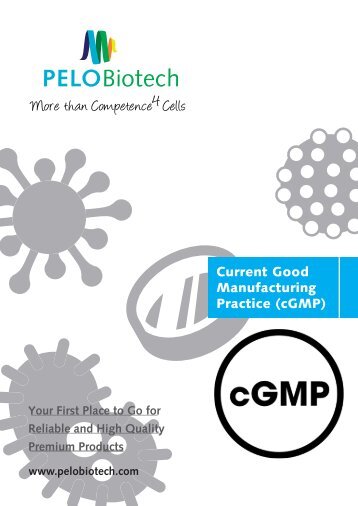PELONews April/May 2019
- Text
- Hydrogel
- Fluorescent
- Pelonews
- Hydrocell
- Pelobiotech
- Primary
PELONews We have talked: Optimised Cancer Treatments and EV research with 3D Models To an expert- talk about “Optimised Cancer Treatments and EV research with 3D Models” invited PELOBIotech GmbH and its Swiss partner abc biopply at the IZB Sky-Lounge end of March 2019. Around 20 scientists from Bavarian biotech companies and institutes such as TUM, LMU, Helmholtz Centre in Munich and Fraunhofer in Regensburg discussed with highlevel cancer research experts Dr. med. Andreas Thomsen and Dr. Irina Nazarenko from Universitätsklinikum Freiburg about new models for tissue-specific interaction of cells and how they optimize their treatments. First Dr. Marco Leu, Co-Owner abc biopply, gave a short overview of a novel and innovative 3D microwell array in the analysis of adhesion independent micro-organoids, named 3D CoSeedis. “I am glad abc biopply was able to collaborate with Dr. Andreas Thomsen and to further develop this unique and novel technology. We are proud to have recently released the first standardizes systems it to the scientific world” says Dr. Leu. 3DCoSeedis allows the support of the growth of feeder cells in the formation of 3D cell constructs that are not in direct contact with the test cells themselves. „It’s totally cool!“ Both key speakers are already working with the new system 3D CoSeedis, as in fact Dr. Thomsen invented the system himself. His lecture “Creating Unique Microenvironments in 3D Models” showed a broad range of applications and inspired the researchers on their projects on tissue-specific interaction of cells. A lot of wows he earned showing his results in comparison with standard 2d methods and the new 3D model. “It makes it so much easier”, the Freiburg radio-oncologist says. His survey “Do you enjoy colony formation assays?” performed among colleagues made the audience laugh. They knew almost everybody dislike it and now are given a possibility to work much more efficient. A lot of interest had the lecture by Dr. Irina Nazarenko: Studying Intercellular Communication by the mean of Extracellular Vesicles in 3D Models. She talked about the impact environment on production, cargo, and function of extracellular vesicles (EVs) in several cancer models. EVs mediate intercellular communication between tumor and tumor stroma, tumor and immune system, playing a pivotal role in metastases, immunosuppression, angiogenesis and other systemic effects in progressing tumor. In her experience 3DCoSeedis TM is applicable for EV isolation, analytic and functional characterization. Using the 3D microwell array more EVs/cell can be isolated in a considerably more cost- and efforts- efficient manner than 2D culture. “My co-workers and me love working with it”, Dr. Nazarenko says, as the cells are growing in more physiological environment and producing more EVs. 3D environments are likely to trigger release of smaller EVs with increased amounts of certain miRNAs and decreased amounts of their target proteins. She also emphasized that functional impact of 3D environment on EVs differs between cell lines and should be individually analyzed. „We are already switching!“ Dr. Nazarenko is more than convinced by the 3D CoSeedis system. Asked whether she would switch if she had the opportunity: “Definitely, it´s genius, totally cool. So, where it makes sense, we are already switching, step by step”, she outlines. One of the participants confirms her point of view: “We are more and more searching for 3D models, also in EV research. So this system sounds very promising to us.” Peek into presentation Dr. Irina Narzarenko and download paper here. Download presentation Dr. med. Andreas Thomsen, and download paper here: Peek into presentation Dr. Marco Leu
Here some impressions of this great 3D model symposium end of March.
- Page 1: PELONEWS WITH FOCUS ON PRIMARY CELL
- Page 5 and 6: Assays&Arrays WHITE PAPER | Off-Tar
- Page 7 and 8: Reversible Fluorescent Dye for Nucl
Inappropriate
Loading...
Mail this publication
Loading...
Embed
Loading...
About us
This website is published by
PELOBIOTECH Gmbh
Am Klopferspitz 19
82152 Planegg/Martinsried
(Phone): +49 89 517 286 59-0
(Fax): +49 89 517 286 59-88
E-Mail: info@pelobiotech.com
Managing directors:
Dr. Lothar Steeb
Dr. Peter Frost
Registergericht/Trade register:
Amtsgericht München HRB 197203
UID-Nr: DE282095341
EORI-Nr.: DE513247033551940
Responsible for the content (V.i.s.d.M.):
Dr. Peter Frost
Linked Sites: Although we thoroughly check all sites linked to our webpage, we decline any responsibility for their contents.






































Follow Us
Instagram
Email
LinkedIn
Twitter